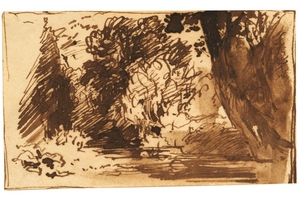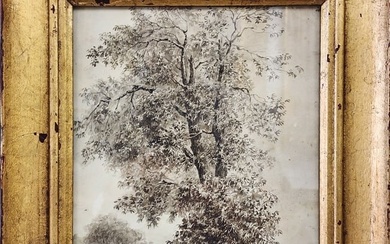JOHN CONSTABLE RA (BRITISH 1776 – 1837) A...
JOHN CONSTABLE RA (BRITISH 1776 – 1837)
A Woodland Glade: possibly a preparatory study for ‘Jaques and the Wounded Stag’, c.1832-5
Pen and brown ink on wove writing paper
64 x 83 mm (2 1/2 x 3 1/4 in)
Provenance: L.G. Duke (D2299, ‘A Pool with Trees’); sold to Chamberlain, October 1951, for £3; Christopher Fry and thence by descent
From around 1830, Constable began to favour the use of brown pen, ink and wash on paper for trying out his compositional ideas. He was familiar with the drawings made in this vein by seventeenth-century French artist Claude Lorrain. He also knew of the imaginary ‘blot’ drawings made in brown washes by the eighteenth-century British artist and drawing master Alexander Cozens – indeed, in 1823 Constable had even made copies after some of Cozens’s published landscape designs. However by 1830 Constable was also deeply involved in supervising the production of a series of mezzotint engravings after his own compositions, known as English Landscape, the chief purpose of which was to demonstrate what he called the ‘chairo’scuro of nature’. It is perhaps not surprising, then, that in his late career he should turn to the use of monochrome media in his drawings similarly to experiment with the expressive potential of light and shade.
The two compositional drawings catalogued here have been examined by paper historian Peter Bower who has confirmed that both of them are made from the same paper, probably a Whatman writing paper. Their small size and drawn ‘frame’ borders would tend to suggest that they might well have been cut from a letter. Certainly Bower has identified other similar small brown ink drawings by Constable of around the same date, some on Whatman paper, which have close associations with written texts – whether transcripts by the artist of poetry, manuscript letters or other draft jottings by him such as variant titles for English Landscape subjects.
The subject of these two related drawings cannot be identified with any certainty. However they bear strong similarities with the designs Constable was working on between about 1832 and 1835 to illustrate the episode from As you Like It of the melancholy Jaques in the Forest of Arden gazing across a swiftly flowing brook towards a wounded stag. The play ( and this episode from it) was a particular favourite with Constable and with his friend and patron Sir George Beaumont.
Constable’s surviving designs made as illustrations to this Shakespearean scene, which are variously in pencil, watercolour or pen and brown ink, relate to two different projects separated by about three years. He made a finished watercolour of the subject in a horizontal format which he exhibited at the Royal Academy in 1832 and for which three related (and similarly horizontal ) designs survive ( see G.Reynolds, The Later Paintings and Drawings of John Constable, 1984, nos. 32.10-12 and Christie, Old Master and British Drawings, 9 December 2015, lot 216). This version of the subject was subsequently engraved (posthumously) for English Landscape. In addition, there are nine surviving upright designs by Constable, nearly all of them executed in pen and brown ink, which relate to a commission the artist received from the publisher John Martin in 1835 to produce an illustrated vignette of the same episode from As you Like It for a volume entitled The Seven Ages of Shakespeare ( see Reynolds, ibid, nos 35.32-35, 35.37-38 and G.Reynolds, The Early Paintings and Drawings of John Constable, 1996, appendix with additions to the Later Paintings, 35.38 A-C).
If the two designs catalogued here do relate to the Jaques subject, it is difficult to say whether they are more likely to be connected – in their rectangular format – to the earlier, horizontal iteration of the subject made in 1832. Or else, perhaps, whether they are early experimental designs in a horizontal format (for an image subsequently rethought in vertical form) made a few years later for John Martin’s Seven Ages; and perhaps originally drawn in a letter from Constable to Martin which was subsequently cut up. Certainly we know from C. R. Leslie that Constable apparently made ‘nearly twenty sketches’ in connection with this latter project.
We are grateful to Anne Lyles and Peter Bower for their assistance in preparing this catalogue entry.
View it on
Estimate
Time, Location
Auction House
JOHN CONSTABLE RA (BRITISH 1776 – 1837)
A Woodland Glade: possibly a preparatory study for ‘Jaques and the Wounded Stag’, c.1832-5
Pen and brown ink on wove writing paper
64 x 83 mm (2 1/2 x 3 1/4 in)
Provenance: L.G. Duke (D2299, ‘A Pool with Trees’); sold to Chamberlain, October 1951, for £3; Christopher Fry and thence by descent
From around 1830, Constable began to favour the use of brown pen, ink and wash on paper for trying out his compositional ideas. He was familiar with the drawings made in this vein by seventeenth-century French artist Claude Lorrain. He also knew of the imaginary ‘blot’ drawings made in brown washes by the eighteenth-century British artist and drawing master Alexander Cozens – indeed, in 1823 Constable had even made copies after some of Cozens’s published landscape designs. However by 1830 Constable was also deeply involved in supervising the production of a series of mezzotint engravings after his own compositions, known as English Landscape, the chief purpose of which was to demonstrate what he called the ‘chairo’scuro of nature’. It is perhaps not surprising, then, that in his late career he should turn to the use of monochrome media in his drawings similarly to experiment with the expressive potential of light and shade.
The two compositional drawings catalogued here have been examined by paper historian Peter Bower who has confirmed that both of them are made from the same paper, probably a Whatman writing paper. Their small size and drawn ‘frame’ borders would tend to suggest that they might well have been cut from a letter. Certainly Bower has identified other similar small brown ink drawings by Constable of around the same date, some on Whatman paper, which have close associations with written texts – whether transcripts by the artist of poetry, manuscript letters or other draft jottings by him such as variant titles for English Landscape subjects.
The subject of these two related drawings cannot be identified with any certainty. However they bear strong similarities with the designs Constable was working on between about 1832 and 1835 to illustrate the episode from As you Like It of the melancholy Jaques in the Forest of Arden gazing across a swiftly flowing brook towards a wounded stag. The play ( and this episode from it) was a particular favourite with Constable and with his friend and patron Sir George Beaumont.
Constable’s surviving designs made as illustrations to this Shakespearean scene, which are variously in pencil, watercolour or pen and brown ink, relate to two different projects separated by about three years. He made a finished watercolour of the subject in a horizontal format which he exhibited at the Royal Academy in 1832 and for which three related (and similarly horizontal ) designs survive ( see G.Reynolds, The Later Paintings and Drawings of John Constable, 1984, nos. 32.10-12 and Christie, Old Master and British Drawings, 9 December 2015, lot 216). This version of the subject was subsequently engraved (posthumously) for English Landscape. In addition, there are nine surviving upright designs by Constable, nearly all of them executed in pen and brown ink, which relate to a commission the artist received from the publisher John Martin in 1835 to produce an illustrated vignette of the same episode from As you Like It for a volume entitled The Seven Ages of Shakespeare ( see Reynolds, ibid, nos 35.32-35, 35.37-38 and G.Reynolds, The Early Paintings and Drawings of John Constable, 1996, appendix with additions to the Later Paintings, 35.38 A-C).
If the two designs catalogued here do relate to the Jaques subject, it is difficult to say whether they are more likely to be connected – in their rectangular format – to the earlier, horizontal iteration of the subject made in 1832. Or else, perhaps, whether they are early experimental designs in a horizontal format (for an image subsequently rethought in vertical form) made a few years later for John Martin’s Seven Ages; and perhaps originally drawn in a letter from Constable to Martin which was subsequently cut up. Certainly we know from C. R. Leslie that Constable apparently made ‘nearly twenty sketches’ in connection with this latter project.
We are grateful to Anne Lyles and Peter Bower for their assistance in preparing this catalogue entry.




